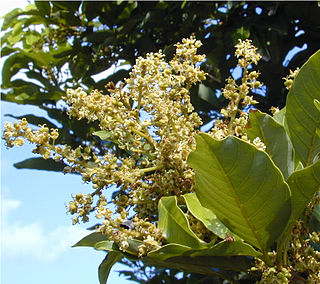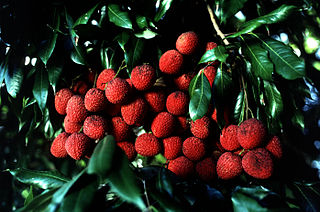
The rambutan is a medium-sized tropical tree in the family Sapindaceae. The name also refers to the edible fruit produced by this tree. The rambutan is native to Southeast Asia. It is closely related to several other edible tropical fruits including the lychee, longan, pulasan and mamoncillo.

A fruit tree is a tree which bears fruit that is consumed or used by humans and some animals — all trees that are flowering plants produce fruit, which are the ripened ovaries of flowers containing one or more seeds. In horticultural usage, the term "fruit tree" is limited to those that provide fruit for human food. Types of fruits are described and defined elsewhere, but would include "fruit" in a culinary sense, as well as some nut-bearing trees, such as walnuts.

Nephelium is a genus of about 25 species of flowering plants in the family Sapindaceae, native to southeastern Asia.

Nephelium hypoleucum, the korlan, is a tree in the family Sapindaceae. It is closely related to several other tropical fruits including the lychee, longan, rambutan, and mamoncillo.

Nephelium ramboutan-ake, the pulasan, is a tropical fruit in the soapberry family Sapindaceae. It is closely related to the rambutan and sometimes confused with it. Other related soapberry family fruits include lychee and longan. Usually eaten fresh, it is sweeter than the rambutan and lychee, but very rare outside Southeast Asia.

A gift basket or fruit basket is typically a gift delivered to the recipient at their home or workplace. A variety of gift baskets exist: some contain fruit; while others might contain dry or canned foods such as tea, crackers and jam; or the basket might include a combination of fruit and dried good items. Gourmet gift baskets typically include exotic fruit, and often include quality cheese and wine, as well as other nonfood items. Gift baskets are often sent for special occasions—such as holidays—or as a thank-you or congratulations gift. In certain occasions, it is given as a sympathy gift or a condolence gift during funerals. In some countries in Asia, people use fruit basket as a decoration. They either eat it after the funeral service where the casket is laid in the cemetery or they leave the fruit baskets at their graves to let the dead rest in peace.
Albonectria rigidiuscula is a fungal plant pathogen. The anamorph of A. rigidiuscula the fungus Fusarium decemcellulare is associated with inflorescence wilt and vascular necrosis in fruit tree crops such as Mango, Longan and Rambutan. F. decemcellulare causes a disease known as cushion gall in Theobroma cacau and other tropical trees.
Nephelium chryseum is a species of plant related to the rambutan. The plant produces edible fruit that are covered in hard red shells with spikey spines. It is native to southern China, Borneo, the Philippines, and Vietnam.
Nephelium juglandifolium is a species of shrub. The drupe fruit is not as round as the other fruits within this genus. The shrub produces small flowers. The plants are grown in parks as decorative ornamental plants. In its natural environment, N. juglandifolium grows in lowland forests. It is usually 30m tall when fully grown.

Conogethes punctiferalis, the durian fruit borer or yellow peach moth, is a moth of the family Crambidae.
Adoxophyes privatana, the appleleaf-curling moth, is a moth of the family Tortricidae. The species was first described by Francis Walker in 1863. It is native to south-east Asia, where it has been recorded from Taiwan, Hong Kong, Hainan in China, Nepal, India, Sri-Lanka, Thailand, Vietnam, western Malaysia, Singapore, Sumatra, Java, Borneo, the Philippines and the Chagos Archipelago. It is an accidental introduction in Great Britain.
The cocoa pod borer is a moth of the family Gracillariidae. It is known from Saudi Arabia, China, India, Thailand, Brunei, Indonesia, Malaysia, Vietnam, Australia, New Britain, the Philippines, Samoa, the Solomon Islands, Sri Lanka, Taiwan and Vanuatu.
Conopomorpha litchiella is a moth of the family Gracillariidae. It is known from Australia, China (Fujian), India, Malaysia (Selangor), Nepal, Taiwan and Thailand.
The litchi fruit borer or the litchi stem-end borer is a moth of the family Gracillariidae. It is present in China, India, Nepal, Taiwan, Thailand and Vietnam.

Alectryon tomentosus, commonly known as the hairy birds eye, red jacket or woolly rambutan, is a rainforest tree of the family Sapindaceae found in eastern Australia. The specific epithet tomentosus refers to the hairy leaves and hairy young shoots.

Geraniin is a dehydroellagitannin found in geraniums. It is found for instance in Geranium thunbergii, which is one of the most popular folk medicines and also an official antidiarrheic drug in Japan. It can also be found in the rind of Nephelium lappaceum (rambutan).

Lancetilla Botanical Garden is a botanical garden and significant tourist attraction located on the coast of the Caribbean Sea, in the north of the Republic of Honduras, about 7 km southeast of the city of Tela.










